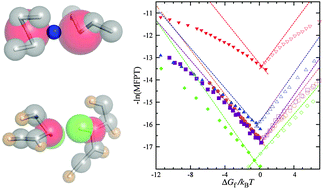Effects of desolvation barriers and sidechains on local–nonlocal coupling and chevron behaviors in coarse-grained models of protein folding
Abstract
Local–nonlocal coupling is an organizational principle in protein folding. It envisions a cooperative energetic interplay between local conformational preferences and favorable nonlocal contacts. Previous theoretical studies by our group showed that two classes of native-centric coarse-grained models can capture the experimentally observed high degrees of protein folding cooperativity and diversity in folding rates. These models either embody an explicit local–nonlocal coupling mechanism or incorporate desolvation barriers in the models' pairwise interactions. Here a conceptual connection is made between these two paradigmatic coarse-grained interaction schemes by showing that desolvation barriers enhance local–nonlocal coupling. Furthermore, we find that a class of coarse-grained protein models with a single-site representation of sidechains also increases local–nonlocal coupling relative to mainchain models without sidechains. Enhanced local–nonlocal coupling generally leads to higher folding cooperativity and chevron plots with more linear folding arms. For the sidechain models studied, the chevron plot simulated with entirely native-centric intrachain interactions behaves very similarly to the corresponding chevron plots simulated with interactions that are partly modulated by sequence- and denaturant-dependent transfer free energies. In these essentially native-centric models, the mild chevron rollovers in the simulated folding arm are caused by occasionally populated intermediates as well as the movement of the unfolded and putative folding transition states. The strength and limitation of the models are analyzed by comparison with experiment. New formulations of sidechain models that may provide a physical account for nonnative interactions are also explored.

- This article is part of the themed collection: The free energy landscape: from folding to cellular function

 Please wait while we load your content...
Please wait while we load your content...